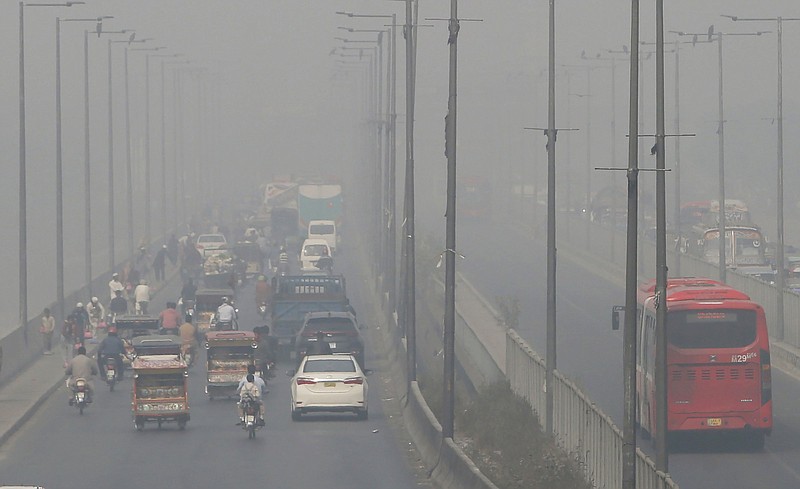GENEVA -- The harmful health effects of air pollution kick in at lower levels than previously thought, the World Health Organization said Wednesday as it set a new standard for policymakers and the public in the first update of its air-quality guidelines in 15 years.
The U.N. health agency released its revised guidance during a week in which climate change is a leading topic at the U.N. General Assembly in New York. Chinese President Xi Jinping announced Tuesday that China will no longer fund power plants fired by coal, which generates several of the pollutants covered by the guidelines.
Since the previous update of the WHO recommendations, better monitoring and science have cleared up the global picture about the effects of six major air pollutants on human health. According to the agency, 90% of the world's people already live in areas with at least one particularly harmful type of pollutant.
"There is nothing more essential for life than air quality," WHO Director-General Tedros Adhanom Ghebreyesus told reporters. "And yet, because of air pollution, the simple act of breathing contributes to 7 million deaths a year. Almost everyone around the world is exposed to unhealthy levels of air pollution."
Air pollution is now comparable to global health risks such as unhealthy diets and smoking tobacco, the WHO said. It is recognized "as the single biggest environmental threat to human health," said Dr. Dorota Jarosinska, the WHO's Europe program manager for living and working environments.
The guidelines, which are not legally binding and are intended as a reference for policymakers, advocacy groups and academics, change the advised concentrations of six pollutants known to have effects on health: two types of particulate matter known as PM 2.5 and PM 10, as well as ozone, nitrogen dioxide, sulfur dioxide and carbon monoxide.
The guidelines could also send a message to the wider public about lifestyle and business choices.
The WHO says the main human-generated sources of air pollution can vary geographically but include the energy and transportation sectors, as well as home cooking and heating. It advised people to do their part by changing their lifestyles -- not running car engines uselessly; avoiding use of plastics that could end up being incinerated; and walking, riding bikes or using public transportation to get to work.
While wealthy countries in Europe, Asia and North America have made strides in improving air quality in recent years, the WHO says that globally, more than 90% of the world population breathes air with PM 2.5 concentrations that exceed the recommended levels in its last guidelines, published in 2006.
Such particles can penetrate deep into the lungs and enter the bloodstream, resulting in both respiratory and cardiovascular effects. Air pollution has been linked to heart disease, diabetes, cancer and early death, and recent evidence has suggested negative effects on pregnancy, cognitive development in kids, and mental health, experts say.
The new guidelines set or revise downward recommended air pollution levels for nearly all of the six particles both on a daily and annual basis. For example, they slashed the PM 2.5 recommendation on an annual basis to 5 micrograms per cubic meter, down from 10 previously.
"That is just a huge change," said Susan Anenberg, associate professor of environmental and occupational health and global health at George Washington University. "This annual average for PM 2.5 in the guidelines is going to be extremely difficult to meet. ... There's very few people on the planet right now that have exposures that are that low."
The 2005 guidelines -- which were published a year later -- prompted many countries to take action even though they are voluntary, the WHO says. Since then, evidence has grown about the negative effects of air pollution on health based on improved pollution measurement systems and exposure assessments.
The revisions highlight an environmental concern that parallels widespread worries about global warming and the effects of burning fossil fuels.
For countries around the world to meet the standards in the new WHO guidance "is going to require major changes to our human systems." Anenberg said. "They have to stop burning fossil fuels, and what the world decides to do about climate change in the coming weeks will have major impacts on whether or not we're able to follow a guideline like that."
A key U.N. climate summit is set to take place in Glasgow, Scotland, in six weeks.
While developed countries and some developing ones have set standards for air quality, a report from the U.N.'s environment program earlier this month found that one-third of the world's countries have no legally mandated standards for the quality of outdoor air. Many of those are in Africa and the Western Pacific.
Over the past 20 years, air quality has improved in places where policies for reducing pollutant emissions have been enforced, including Europe, the U.S. and Canada, said Vincent-Henri Peuch, director of the European Union's Copernicus Atmosphere Monitoring Service.
China has seen improvements, too. But air quality has deteriorated in many other parts of the world, especially in low-income countries, Peuch said.
